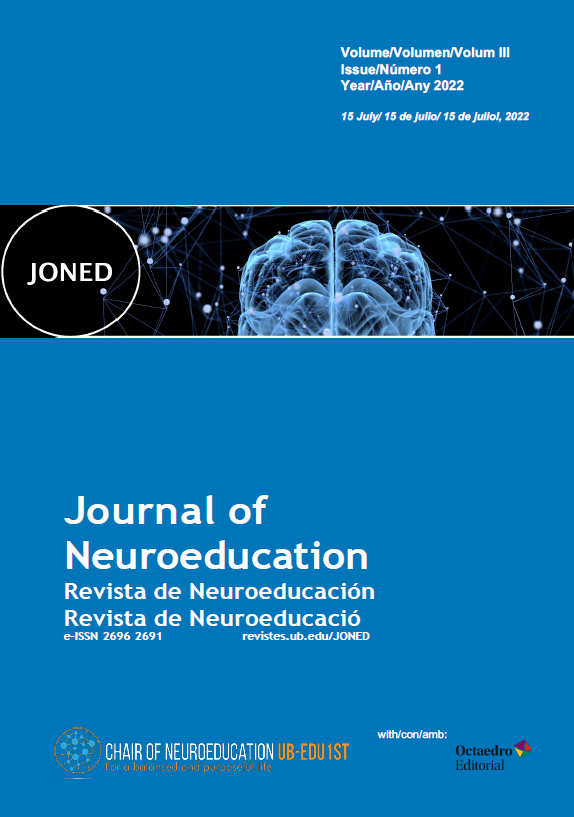La bola de cristal
Una aproximación a la neuroeducación en la etapa de Educación Primaria
DOI:
https://doi.org/10.1344/joned.v3i1.38320Keywords:
Primary School, universal design for learning, cognitive functions, wellbeing, growth mindsetAbstract
Scientific research related to growth mindset, academic success and wellbeing was analysed in a report made by David Bueno I Torrens (1) for the UNESCO International Bureau of education. The idea of intellectual abilities been malleable, even the intelligence, has led to many schools and educational systems to adopt growth mindset interventions. Similarly, if a student understands how the brain works and learns, his/her intellectual ability can improve; he/she can begin to gain a sense of control about their own learning. The main reason for this didactic experience is to answer a question: if the brain is the operations director used for all processes by the students, should not they know how to best use it in order to learn? It would be interesting to introduce the brain knowledge through the learning in primary education. Students use and develop memorization process, attention, inhibitory control, cognitive flexibility… but they are not aware of it many times. In relation to Universal Design for Learning, identified by its acronym UDL, by Rose and Meyer (2), It is required that the three brain networks (recognition, strategic and affective) are activated more than once in order to allow the learning to happen in the brain. To influence in these three networks and to enhance our brain’s apprenticeship, we will discover, justify and develop different methodologies related to: collaborative learning, plastic expression and kinesthetic learning, thinking routines and gamification. Once this didactic experience has been implemented, and the students learning rythm has been assessed, it can be confirmed that the students have learnt a different point of view about the brain, as a structure and as a tool, given that these methodologies have a scientific validity that proves an impact in learning. Projects of emotional learning have been implemented in the curriculum in last years. Thus, it could be taken into advantage to approach neuroscience basic knowledge from it, given that they are useful functions in social and personal development.
References
Bueno D. Growth in learning, academic attainment, and well-being. IBRO/IBE-UNESCO Science of Learning Briefings. 2021; pp. 1-18.
Meyer A, Rose DH. Teaching Every Student in the Digital Age. Universal Design for Learning. Alexandria, VA: Associatión for Supervision and Curriculum Development. 2002.
Blackwell LS, Trzesniewski KH, Dweck CS. Implicit theories of intelligence predict achievement across an adolescent transition: A longitudinal study and an intervention. Child Development.2007; 78(1):246–263.
Dweck C. “Mindsets and math/science achievement”. Carnegie-IAS Commission on Mathematics and Science Education. 2008.
Hanson JL, Hair N, Shen DG, Shi F, Gilmore JH, et al. Correction: Family Poverty Affects the Rate of Human Infant Brain Growth. PLOS ONE. 2015; 10(12): e0146434.
Adesope O et al. Rethinking the use of tests: a meta-analysis of practice testing. Review of Educational Research. 2017; 87: 659-701.
Thompso, RA, Nelson CA. Developmental science and the media: Early brain development. American Psychologist. 2001; 56(1): 5–15.
Mora F. Neuroeducación: sólo se puede aprender aquello que se ama. Alianza Editorial. 2013.
Willis J. “Cooperative learning is a brain turn-on”. Middle School Journal. 2007.
Sousa, D, Pilecki, T. From STEM to STEAM: Using Brain-Compatible Strategies to Integrate the Arts. Thousand Oaks, CA: Sage. 2013; 280 pp.
Hardiman M et al. “The effects of arts integration on long-term retention of academic content”. Mind, Brain and Education. 2014; 8(3): 144-148.
Diamond A, Ling DS. “Conclusions about interventions, programs, and approaches for improving executive functions that appear justified and those that, despite much hype, do not”. Developmental Cognitive Neuroscience. 2016; 18: 34-48.
Downloads
Published
Issue
Section
License
Copyright (c) 2022 Alejandro Lolumo Peiro

This work is licensed under a Creative Commons Attribution-NonCommercial 4.0 International License.
The authors who publish in this journal agree to the following terms:
a. Authors retain copyright and grant the journal the right of first publication
b. Texts will be published under a Creative Commons Attribution Non Commercial License that allows others to share the work, provided they include an acknowledgement of the work’s authorship, its initial publication in this journal and the terms of the license, and not for commercial use.



